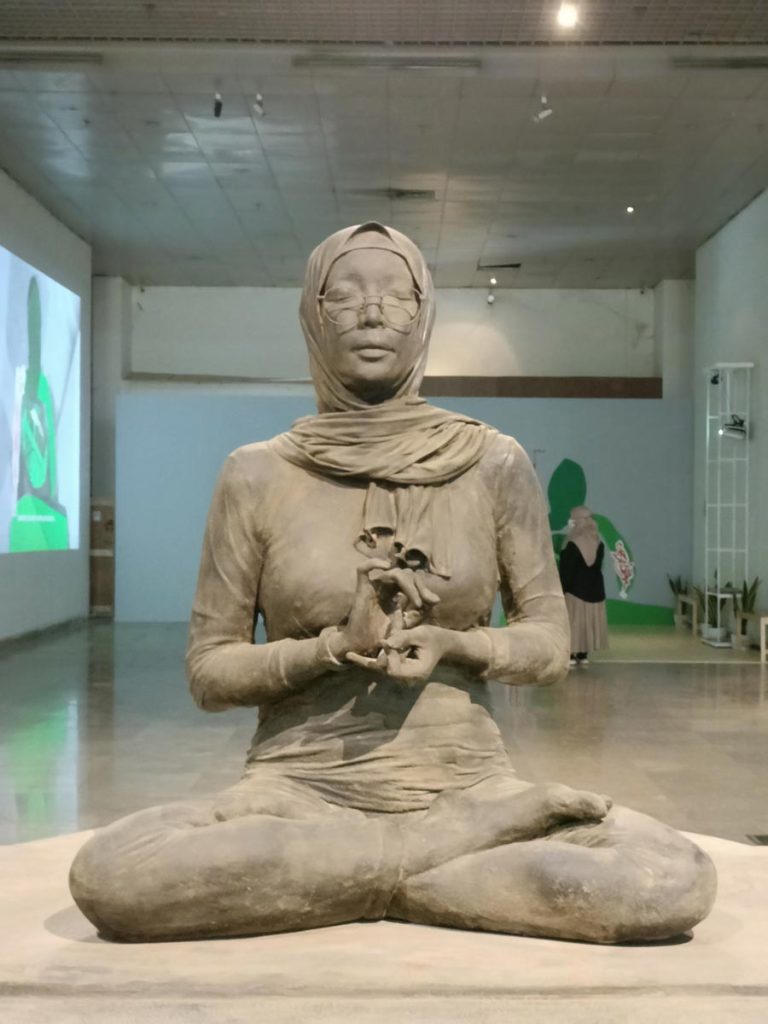
A young Indonesian lady wearing a hijab sits crossed-legged, making the Dharmachakra mudra hand gesture, meditating on a yoga mat positioned upon a lotus throne. The beautiful life-sized sculpture, ‘Sri Naura Paramita,’ its creator stylised as the subject, is immediately compelling, tinged with light-heartedness, yet packs a mighty blow. The sculpture by emerging Bandung multi-disciplined contemporary artist Alfiah Rahdini was one of the outstanding works of the 2021 Jakarta Biennale ESOK presented at the National Museum of Indonesia until January 2022.
According to Islamic moral ideals, artworks with figurative references are considered blasphemous and are socially unacceptable. In the recent past, large-scale public artworks in West Java were subject to heated protests and censorship by radical minority religious groups and later destroyed. In response, Alfiah makes a profound contemporary art statement by merging Buddhist and Islamic influences into a singular expression. ‘Sri Naura Paramita,’ is an intelligent and extraordinary interpretation of gender identity politics, pointing the finger towards Indonesian society’s patriarchal paradigm.
Beyond its serene aura, ‘Sri Naura Paramita’ speaks of duality, the collision of the past and present and a fascinating encounter of contrasting cultures in modern Indonesia. It inspires thoughts of Bhinneka Tunggal Ika, the official national motto inscribed on the National Emblem of Indonesia, meaning Unity in Diversity. It refers to the unity and integrity of the nation consisting of various cultures, regional languages, races, ethnicities, religions, and beliefs. The artist’s breakthrough is distinguishing ‘Sri Naura Paramita’ with a hijab while embodying the Buddha’s peaceful spirit and neutralising any possibility of widespread criticism.
“In my work “Sri Naura Paramita”, I am striking the same pose as the statue of Prajnaparamita, the Buddhist deity of transcendental wisdom, which was created in the classical Javanese era around the 13th-14th centuries AD,“ Alfiah Rahdini told NOW! Jakarta Magazine. “In Buddhism, the Dharmachakra mudra symbolises the turning of the wheel of Dharma. This mudra is usually used by Vairocana, to transform ignorance into knowledge of the Buddha’s Dharma. ‘Sri Naura Paramita’ received positive responses from visitors to the Jakarta Biennale. A 16-year-old Buddhist teenager created a dance and music piece in response to the work,” Alfiah told me.


Born in February 1990 in Bandung, West Java and educated 2008 – 2014 at Bandung Institute of Technology (ITB), Faculty of Art and Design BFA (Bachelor of Fine Art), Sculpture Department and from 2020, ongoing at Sanata Dharma University, Master of Arts in Cultural Studies, Alfiah expresses herself through sculpture, performance, participatory art, installation, and site-specific works. She represents the emerging generation of female Indonesian contemporary artists who speak of delicate yet poignant multi-dimensional local and universal issues in an eye-catching language spanning social-political, cultural, religious, and philosophical perspectives that inspire imagination and invite contemplation.
Alfiah’s themes endeavour to bring awareness to the cultural and social pressures placed upon women increasingly regulated by conservative Islamic ideology and the need to monitor their outward physical appearances. In contrast, Indonesian men are without restrictions. Her methodology is to create public artworks positioned in critical community locations to solicit attention and response.
Public art within major cities of Indonesia has a distinct national history. The founding father and first president of the Republic of Indonesia, Sukarno, studied engineering and briefly practised as an architect before entering politics. Sukarno commissioned large-scale public artworks to impact the identity of the nation’s people positively. He was driven by a vision for a new and united country free from colonial oppression, entering into a prosperous new future built upon the human spirit’s courage and vast creative potential. Alfiah believes that women should be free to express themselves without being psychologically terrorised by stigma caused by conservative ideology.

‘Sailor Moonah #2’ was created in 2022, following on from ‘Sri Naura Paramita’. Again, Alfiah stars as the subject in a colourful life-sized fibreglass sculpture depicting an Indonesian woman cosplaying an iconic Japanese anime character wearing a hijab. It was displayed in public spaces, such as city parks, with a wider range of appreciators. The statue is another example of modern global culture and the ever-changing notion of Indonesian identity. The work challenges stereotypes and empowers Muslim Indonesian women.
In 2019, Alfiah received critical acclaim being awarded the Best Artwork in the Basoeki Abdullah Art Award 2019, Basoeki Abdullah Museum, Ministry of Education and Culture of Indonesia and the Runner up Art in Public Space Competition, Omah Munir Museum, Jakarta Arts Institute, and TIFA Foundation, Jakarta. Alfiah has recently exhibited in the USA, Japan and Bali. ‘Sri Naura Paramita’ is currently on display in the Netherlands until April 2024 in the group exhibition The Great Indonesia, at De Nieuwe Kerk, Amsterdam, where her sculpture is side-by-side with some of Indonesia’s leading names, such as Heri Dono and FX Harsono.
An artist of the new paradigm, Alfiah Rahdini holds a guiding light, helping to show us where we have come from and where we are going to.
Follow her directly on Instagram: @alfiah.rahdini






